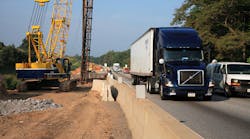In their heart of hearts, no one really likes rules in trucking, much less the transportation and logistics industry as a whole.
Now, many may rightly say this rule or that regulation is needed to improve safety, but really, at the end of the day for most fleets, a rule ends up being just one more headache – one more item on the checklist of life that needs to be crossed off – on the road making a living hauling freight.
[For some interesting “inside baseball”-style insight into how the rules governing transportation get made, go here, here, and here.]
Yet here’s an interesting twist to add to this discussion regarding rulemaking: are regulations actually hindering the refurbishment of our nation’s transportation infrastructure?
None other than U.S. Secretary of Transportation Elaine Chao touched on this line of thought during her speech yesterday at the Department of Transportation (DOT) “open house” ceremony as part of the agency’s ongoing 50th anniversary celebrations.
[Lyndon Johnson’s administration founded the DOT we know and love today, with the agency going into “full operation” on April 1, 1967. Click here for a detailed history on the DOT’s somewhat tortured creation.]
Chao noted that President Trump’s infrastructure initiative – which she said “will be announced later this year” – will be a “strategic, targeted program of investment” valued at $1 trillion over 10 years; one that will also cover more than transportation infrastructure by including energy, water and potentially broadband and veterans hospitals, as well.
“The President’s plan hopes to unleash the potential for private investment in infrastructure by incentivizing public-private partnerships … and investors say there is ample capital available, waiting to invest in infrastructure projects,” Chao said. “So the problem is not money. It’s the delays caused by government permitting processes that hold up projects for years, even decades, making them risky investments.”
Even transportation safety itself seems to be threatened (if I can use that word) by the tidal wave of regulations crafted over the last several years, according to new report from the Competitive Enterprise Institute (CEI) with this overly-long and clunky title: Toward Performance-Based Transportation Safety Regulation: Focus on Results Instead of Rigid Rules to Improve Safety and Promote Innovation.
“Safety is a major concern when it comes to transporting passengers and freight around the country, but too often regulators make it difficult for industries to find new, innovative ways to meet their safety goals,” noted Marc Scribner, CEI senior fellow and author of group’s report, in a statement.
More bluntly, he added that businesses and entrepreneurs have “long complained” about having to comply with unnecessarily rigid regulations that stress adherence to administrative rules rather than performance-based regulations, which focus on results.“The best way to improve transportation safety is to replace government micromanaging with performance goals, which would hold industries more accountable and encourage new technologies and practices that improve safety,” Scribner said.
CEI’s data indicates that the “more prescriptive” transportation safety rule – the ones most truckers dislike – are generally found in the pipeline, aviation, trucking, and railroad regulatory regimes.
“Prescriptive rules, in addition to being more onerous for the regulated entities, often produce additional social costs by hindering innovation,” CEI noted in its report.
One example it used to illustrate this problem is the debate over replacing rear and side-view mirrors with cameras – an argument truck engineers are deeply engaged in, especially in terms of fuel economy improvement efforts.
CEI noted in its report that new camera and sensor technologies can obviate the need for rearview mirrors by either replacing the mirrors’ viewing function with cameras or by eliminating the need for driver viewing by automating the driving function completely.
[But don’t bet on automated trucks hitting the road en masse anytime soon.]
Yet Federal Motor Vehicle Safety Standard (FMVSS) 111 currently requires that all passenger cars have side-view mirrors on both the driver and passenger side and rearview mirrors inside – period. No if’s, and’s or but’s.
So now we turn to the November 2015 request from Google for an interpretation of FMVSS 111 from the National Highway Traffic Safety Administration (NHTSA) office of chief counsel for a waiver from this rule.
Why? Google – as we all know – had by that date developed a fully self-driving automobile and was asking about the possibility of alternative rearview mirror compliance with sensors, as the Google prototype eliminated the need for what CEI called “human driver monitoring.”
But in February 2016, CEI noted that NHTSA’s chief counsel replied that under current law, “it cannot interpret Google’s [self-driving vehicle] as compliant with these standards and requirements. This would need to be undertaken through rulemaking.”
NHTSA did entertain the possibility of Google obtaining an exemption in the future from FMVSS 111, but CEI the agency concluded such an exemption would not permit large-scale production and deployment, as current law caps exemptions at 2,500 units per year for two years.
That same month, CEI noted that NHTSA “favorably interpreted” FMVSS 111 to permit the inside rearview mirror to double as a rearview camera display, but this permits cameras and driver displays only as supplements to mirrors, not replacements.
And all of this is going on even as NHTSA is mandating the installation of rear-view camera systems on all light vehicles weighing under 10,000 lbs. manufactured on or after May 1 next year – trucks and buses included.
One would think that rulemaking effort would’ve convinced NHTSA to be more open-minded about cameras. But not yet it seems. And perhaps that’s why in the larger context rulemaking can bog down infrastructure repair and expansion efforts. We’ll see if that holds true going forward.






